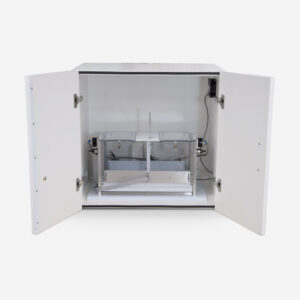Shuttle Box Learned Helplessness Protocol
Summary
- Training delivers many trials of aversive stimulation using one compartment of the shuttle box
- Testing determines if repetitive aversive stimulation is associated with deficits in escape responding
- User-defined independent variables include: (default values)
- Tone Duration = 5 sec
- CS/UCS Overlap = 1
- Escape Interval = 10 sec
- Aversive Stimulus Duration = 1-10 sec (random)
- ITI period = 2–15 sec (random)
- Total Training Trials Run = 180
- Total Testing Trials Run = 30
- Acclimation Period = 120 sec
- Avoid Interval = 5 sec
- Data collected includes:
- Avoids
- Escapes
- Crossings
TRAINING PHASE
- Subject is loaded into either side of the chamber.
- On START command, the program detects if the subject has been loaded into the chamber.
- If so, the experiment begins with both lights turning on, and the door opens.
- The ITI period begins, then a tone signals the end of ITI as an aversive stimulus is delivered. The program alternates between these two phases until the specified number of trials to run has completed.
TESTING PHASE
- Subject is loaded into either side of the chamber.
- On START command, program detects if the subject has been loaded into the chamber.
- If so, the experiment begins. Both lights turn on, the door opens, and the acclimation period begins.
- After acclimation, the door closes for an ITI period. Once that ends, the door opens, a tone is presented in the same side as the subject, and the trial begins.
- Trial begins with the avoid interval. If the subject crosses over to the other side of the chamber during this time, an avoid is recorded and the trial ends.
- If the subject does not cross over to the other side of the chamber before the end of the avoid interval, the escape interval begins, the aversive stimulus turns on.
- If the CS/UCS overlap, the tone will stay on until the aversive stimulus turns off.
- If the subject crosses over to the other side of the chamber during the escape interval, an escape is recorded, the aversive stimulus turns off, and the trial ends.
- At the end of the escape interval, if the subject has not crossed over to the other side of the chamber, the aversive stimulus is turned off, a failure to escape is recorded, and the trial ends.
- At end of each trial, the door closes and the tone turns off.
- Then, another ITI period, followed by another trial until the number of trials to run has been reached.
- At the end of experiment, the lights turn off and the door closes.
SKU: SOF-700RA-28
Specifications
- Shuttle Box Size:
- Standard
- Species:
- Mouse+Rat
Request a Consultation
Our experts are standing by to help you put together the perfect package for your needs. Just fill out our request form and a team member will get back to you within 1 business day.



